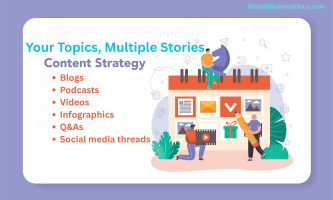Digital PR: The Gamechanger Of The Marketing Landscape

Digital marketing has changed the face of marketing and given small-to-medium enterprises (SMMEs) and start-up firms the opportunity to sell their products and services in the same manner as major corporations, hence it meets the definition of a game changer.
Digital marketing really outperforms traditional marketing, such as advertising in magazines or newspapers, in that it allows you to track the success of your advertising and determine where you should focus more of your marketing budget.
What Is Digital PR?
Public relations techniques known as “digital PR” are used to advance and safeguard a brand’s online reputation. In order to reach and engaging target audiences, it entails producing and distributing content, establishing connections with important influencers, and utilizing social media and other digital channels.
Digital PR agency uses the power of the internet to reach a larger, more varied audience than traditional PR, which mostly relied on print and broadcast media. It also offers options for real-time engagement and two-way communication with audiences and enables more accurate monitoring of the impact of PR activities. Digital PR aims to improve a brand’s reputation online, boost its exposure and trustworthiness, and increase website traffic and sales.
Importance Of Digital PR In The Marketing Landscape
A bigger and more diversified audience can be reached by firms via digital channels like social media, influencer marketing, and content distribution thanks to digital PR.
Cost-effectiveness: Digital PR is more economical than traditional PR because it does not require costly print and television commercials.
Measurable outcomes: Digital PR makes it possible to monitor and gauge the success of PR initiatives, enabling ongoing optimization and development.
Real-time interaction: Digital PR enables brands to interact in real-time with their target market, enabling two-way dialogue and developing a sense of community.
Integration with other marketing initiatives: To increase impact and reach, digital PR may be readily combined with other digital marketing initiatives like search engine optimization (SEO) and social media marketing.
Building and keeping an online reputation: As customers are more likely to accept suggestions from reliable sources and influencers than commercials, digital PR is essential for both building and sustaining an online reputation for a firm.
Key Components Of Digital PR
Content creation and distribution: The creation and delivery of high-quality, pertinent, and interesting material are key components of digital public relations. These digital channels include blogs, infographics, videos, and social media posts.
Influencer marketing: By collaborating with influencers who have a sizable and active following, a brand’s message may be amplified, and it can reach new audiences.
Social media engagement: Social media platforms give brands the chance to interact with their target market and instantly address queries, complaints, and issues.
Influencer marketing: Influencer relationships are essential for the success of digital PR because they may aid a business by generating buzz, driving traffic, and establishing a reputation.
Social media engagement: Reaching out to the media and pitching topics to journalists and relevant media outlets can help secure media coverage and boost exposure for the brand.
Data and analytics: To evaluate the efficacy of PR initiatives and make wise choices, digital PR includes monitoring and tracking indicators, such as website traffic, social media engagement, and influencer reach.
Brand reputation management: Digital PR includes keeping an eye on and maintaining a brand’s online reputation, as well as handling any bad press and preserving the brand’s reputation.
Rise Of Digital Media And The Need For Digital Pr
The development of digital media has significantly changed how companies interact with and reach out to their target markets. Consumers are spending more time online and consuming more digital information than ever because of the ubiquitous use of the internet and the growth of digital gadgets. As a result of this shift in consumer behavior, brands now have new opportunities to connect with and engage with their target audience via digital channels.
As a result of the overwhelming amount of information customers are exposed to and their growing skepticism of conventional advertising, new problems have arisen. In this setting, digital PR has grown in significance as a means for firms to connect with their target market, establish credibility, and set themselves apart from their competitors.
Digital PR gives brands the chance to reach new audiences, interact with their target audience in real-time, and establish and uphold a good online image by utilizing digital media. It may assist organizations in establishing themselves as thought leaders and gaining the trust of their target audience by producing and disseminating high-quality, pertinent, and engaging content, as well as developing connections with important influencers and media sources.
Digital PR Tactics:
Content Creation And Distribution:
The production and dissemination of content are one of the most essential elements of digital PR. Brands can become thought leaders in their field and gain the trust of their target audience by producing high-quality, timely, and interesting content. There are numerous ways to present content, such as blog entries, infographics, films, social media posts, and more.
Brands may reach a larger and more varied audience by distributing this information through digital channels like social media, email marketing, and content distribution networks. In order to extend the audience of content and secure media coverage, which can help raise visibility and boost website traffic, digital PR also entails the use of influencer marketing.
Influencer Marketing:
Another essential element of digital PR is influencer marketing, which enables businesses to partner with people who have huge and active followings in order to reach new customers and establish a reputation. Working with influencers allows brands to access their fan base, expand the reach of their message, and establish them as thought leaders in their field.
Product reviews, sponsored content, and social media updates are just a few examples of the varied ways influencer marketing may be used. Influencer marketing may be a very efficient approach to reaching new audiences, raising brand awareness, and establishing brand reputation when done right.
Social Media Engagement:
An important element of social media engagement in digital PR is the chance it gives firms to interact in real-time with their target audience and establish a solid online reputation. Brands can interact with customers on social media to reach new audiences, address their concerns, and foster brand awareness and adherence.
Brands can use social media channels to create and share high-quality, relevant, and interesting content, participate in influencer marketing campaigns, respond to customer questions and grievances immediately, and grow a loyal following.
Media Outreach And Pitching:
As they give brands opportunities to acquire media coverage and establish trust with their target audience, link-building and pitching are essential elements of digital PR. Brands may share their story, spread their message, and position themselves as thought leaders in their sector by contacting journalists, bloggers, and other media sources.
Digital PR specialists need to have a thorough awareness of the media environment and be able to recognize the journalists and outlets that are most appropriate for their business.
Measuring The Success Of Digital PR:
Setting Goals And Kpis:
A crucial step in gauging the effectiveness of digital PR campaigns is creating goals and KPIs. It can be challenging to evaluate the results and efficacy of digital PR activities without specific goals and KPIs.
The following are some common goals and KPIs for digital PR:
Increased brand awareness: Through digital PR, brands can aim to become more visible and connect with new audiences. Tracking indicators like website traffic, social media interaction, and media placements can be used to gauge this.
Better reputation management: Digital PR can be utilized to improve a brand’s online reputation and immediately address unfavorable comments. Tracking measures like sentiment analysis, customer reviews, and online mentions can be used to gauge this.
Tracking And Analysing Metrics:
Digital PR relies heavily on tracking and analyzing data since it enables marketers to gauge the success and impact of their initiatives. Brands may use metrics and analytics to continuously improve their outcomes and make data-driven decisions about their digital PR strategy.
Some frequent KPIs used in digital PR include the ones listed below:
Media placements: Tracking media placements, such as those in articles, blogs, and news stories, can give you an idea of how visible and well-known your brand is.
Website traffic: Analysing website traffic, such as the number of unique visitors and pageviews, can give information on how well digital PR campaigns have been done at directing people to a brand’s website.
Social media engagement: Tracking engagement indicators on social media, such as likes, comments, shares, and follows, can help determine how successful a campaign is.
Conversion rate: Analysing the conversion rate—the proportion of website visitors who complete an activity, like making a purchase or subscribing to a newsletter—gives information on how well digital PR works to encourage conversions.
Sentiment analysis: Using sentiment analysis, such as keeping track of the tone of online comments and reviews, can give information about how the public views a business and how digital PR activities have affected reputation management.
Conclusion:
With technology evolving continually and new digital channels emerging, the future of digital PR looks very promising. To make the most of the technology in the marketing landscape, you must hire a digital PR agency and acquire its benefits.
Read Also:















